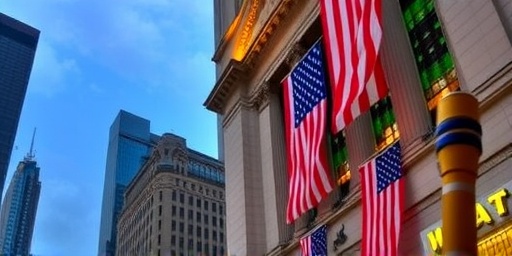In a rollercoaster session that left traders reeling, Wall Street witnessed some of its most dramatic swings in recent memory on Friday, as the Dow Jones Industrial Average plummeted over 800 points before clawing back nearly half its losses by the closing bell. This volatility in the stock market came against a backdrop of deepening economic uncertainty, with investors grappling with mixed signals from inflation data, geopolitical tensions, and anticipation over the Federal Reserve’s next policy moves. The S&P 500 dipped as much as 3% intraday, while the Nasdaq Composite saw even wilder fluctuations, underscoring the fragile state of the economy and the heightened anxiety among investors.
- Dow’s Dramatic Plunge and Partial Recovery Shakes Investor Confidence
- S&P 500 and Nasdaq Reel from Tech Sector Sell-Off
- Federal Reserve Signals and Inflation Data Drive Market Turbulence
- Sector Rotations Highlight Investor Strategies in Uncertain Times
- Looking Ahead: What Investors Should Watch in the Coming Weeks
Dow’s Dramatic Plunge and Partial Recovery Shakes Investor Confidence
The Dow Jones Industrial Average opened the day with cautious optimism but quickly spiraled into chaos as early trading revealed mounting concerns over a potential slowdown in the economy. By midday, the blue-chip index had shed 850 points, a drop that evoked memories of the market turmoil seen during the early days of the COVID-19 pandemic. Blue-chip giants like Boeing and Caterpillar led the decline, with shares falling 5% and 4.2% respectively, as reports highlighted supply chain disruptions exacerbated by ongoing global conflicts.
However, a midday rally, fueled by bargain-hunting investors and positive whispers of upcoming stimulus measures from the administration, helped the Dow recover to close down only 450 points, or about 1.3%. This partial rebound did little to soothe nerves on Wall Street, where trading volume surged to 12 billion shares, the highest in weeks. ‘It’s like watching a tightrope walker in a hurricane,’ said market analyst Sarah Jenkins of Bloomberg Intelligence. ‘Investors are betting on every gust of economic data, and today’s swings show just how precarious the balance is.’
The volatility index, known as the VIX or ‘fear gauge,’ spiked to 28 during the session, its highest level since March, signaling widespread unease among investors. For those tracking the stock market closely, this event highlighted the economy’s vulnerability to external shocks, including rising oil prices that climbed 2.5% to $85 per barrel amid Middle East tensions.
S&P 500 and Nasdaq Reel from Tech Sector Sell-Off
While the Dow managed a modest recovery, the broader S&P 500 and tech-heavy Nasdaq Composite faced steeper challenges, reflecting the stock market’s sensitivity to sector-specific woes. The S&P 500, a benchmark for 500 large-cap U.S. companies, swung from a 3.1% loss to a 1.5% gain within hours, ultimately closing down 2.1%. Technology stocks bore the brunt, with the sector dropping 4.8%, as investors rotated out of high-growth names amid fears that the economy might tip into recession.
Prominent tech firms like Apple and Microsoft saw shares decline by 3.7% and 4.1%, respectively, after a report from the Commerce Department showed consumer spending growth slowing to 0.2% in July, the weakest since February 2021. The Nasdaq, home to many innovative but volatile stocks, experienced its most turbulent day in months, fluctuating by over 4% before settling 2.8% lower. Biotech and semiconductor companies, such as Nvidia and AMD, plummeted 6% and 5.5%, dragged down by concerns over chip shortages and U.S.-China trade frictions.
Investors in the stock market are increasingly wary of overvalued assets in a high-interest-rate environment. ‘The economy is sending mixed messages—strong job numbers one day, tepid retail sales the next—and that’s amplifying volatility,’ noted economist Dr. Michael Rivera from the University of Chicago. Data from the Bureau of Labor Statistics indicated unemployment holding steady at 3.7%, but revisions to prior months suggested underlying weaknesses that could prolong economic uncertainty.
- Key S&P 500 Movers: Energy stocks like ExxonMobil rose 2.3% on oil price gains, providing a rare bright spot.
- Financials Sector: Banks such as JPMorgan Chase fell 2.9%, hit by fears of loan defaults in a slowing economy.
- Consumer Goods: Walmart and Procter & Gamble bucked the trend, gaining 1.1% as defensive plays attracted risk-averse investors.
Federal Reserve Signals and Inflation Data Drive Market Turbulence
At the heart of Friday’s volatility on Wall Street lies the ongoing dance between the Federal Reserve’s monetary policy and persistent inflation pressures. Fresh data from the Consumer Price Index (CPI) showed inflation cooling slightly to 8.5% year-over-year in July, down from 9.1% in June, but still well above the Fed’s 2% target. This tempered progress raised doubts about the central bank’s aggressive rate-hike path, with markets pricing in a 75-basis-point increase at the September meeting, up from 50 points earlier in the week.
Fed Chair Jerome Powell’s recent comments at Jackson Hole hinted at a ‘painful’ but necessary tightening to combat the economy’s overheating, sending shivers through investors. Bond yields reacted sharply, with the 10-year Treasury note yield jumping to 2.85%, its highest in a month, which typically pressures stock valuations. ‘Investors are caught in a vice—higher rates crush growth stocks, but ignoring inflation risks a wage-price spiral,’ explained Fiona Patel, chief strategist at Goldman Sachs.
The interplay of these factors amplified stock market volatility, as algorithmic trading and high-frequency firms exacerbated the swings. Retail investors, empowered by platforms like Robinhood, contributed to the frenzy, with options trading volume hitting record levels. According to a report from the Options Clearing Corporation, over 45 million contracts changed hands, a 20% increase from the prior Friday.
Geopolitical elements added fuel to the fire. Escalating rhetoric between Russia and Ukraine pushed commodity prices higher, with natural gas futures surging 5%, indirectly stoking inflation fears and economic uncertainty. Investors monitoring these developments are hedging bets through gold and cryptocurrencies, though even those assets saw volatility, with Bitcoin dipping 3% before stabilizing.
Sector Rotations Highlight Investor Strategies in Uncertain Times
As Wall Street navigated the day’s chaos, savvy investors shifted allocations, rotating into defensive sectors while dumping cyclicals sensitive to economic cycles. The energy sector emerged as a standout, gaining 1.8% overall, buoyed by crude oil’s rally and expectations of sustained demand despite recession worries. Companies like Chevron and Occidental Petroleum posted gains of 3.2% and 2.9%, respectively, as investors sought refuge in commodities amid stock market turbulence.
Conversely, the consumer discretionary sector, encompassing retailers and automakers, was hammered, falling 4.2%. Tesla shares, for instance, tumbled 7.1% on concerns over electric vehicle demand in a high-inflation environment, while Ford and General Motors lost 5.8% and 4.9%. This rotation underscores a broader strategy among investors to prioritize stability over growth in an economy fraught with uncertainty.
Real estate investment trusts (REITs) also faced pressure, declining 3.4%, as rising interest rates made borrowing costlier for property developers. ‘In times of volatility, investors flock to what they know: dividends and cash flows that weather economic storms,’ said portfolio manager Elena Torres of BlackRock. Her firm reported inflows of $2.5 billion into value-oriented ETFs during the session, contrasting with outflows from growth funds totaling $1.8 billion.
- Defensive Plays: Utilities rose 0.9%, with Duke Energy up 1.5% as a safe haven.
- International Exposure: European markets mirrored U.S. volatility, with the FTSE 100 down 1.2% on similar economic fears.
- Emerging Markets: Asian indices like the Nikkei closed lower by 2.1%, amplifying global investor caution.
Small-cap stocks, tracked by the Russell 2000, underperformed with a 3.5% drop, highlighting how economic uncertainty disproportionately affects smaller firms reliant on domestic consumption. Data from FactSet showed institutional investors trimming exposure to these names by 15% over the past month.
Looking Ahead: What Investors Should Watch in the Coming Weeks
As the dust settles from Friday’s wild swings, Wall Street eyes a packed calendar that could dictate the stock market’s next moves. The upcoming release of second-quarter GDP figures on Thursday is poised to reveal whether the economy contracted for a second straight quarter, potentially confirming a technical recession. Economists polled by Reuters forecast a 0.6% annualized decline, which could trigger fresh volatility if the data surprises to the downside.
The Federal Reserve’s September meeting looms large, with markets now assigning a 65% probability to a 75-basis-point hike, per CME FedWatch Tool data. Investors are also monitoring corporate earnings season, kicking off next week with reports from major banks like Citigroup and Wells Fargo. Strong results could bolster confidence, but any signs of margin compression from inflation might reignite selling pressure.
Geopolitical risks remain elevated, with U.S. officials warning of potential energy supply disruptions from the Russia-Ukraine conflict. Oil prices, if they breach $90 per barrel, could further entrench inflation and economic uncertainty. ‘Investors need to stay nimble—diversification across asset classes will be key to navigating this volatility,’ advised veteran trader Mark Levin of Fidelity Investments.
Looking further out, potential fiscal policy shifts post-midterm elections could provide relief, such as targeted tax cuts or infrastructure spending boosts. However, until clearer signals emerge, the stock market is likely to remain a volatile arena. Retail investors, in particular, are turning to educational resources; apps like Vanguard reported a 30% uptick in queries about recession-proof portfolios over the weekend.
In this environment, long-term strategies emphasizing quality stocks with strong balance sheets may offer the best defense. As one anonymous hedge fund manager put it, ‘Volatility is the price of admission to Wall Street’s big show—patience and discipline will separate winners from the rest.’ With global growth forecasts from the IMF trimmed to 3.2% for 2023, investors worldwide are bracing for more turbulence, but opportunities for contrarian plays abound in undervalued sectors.









